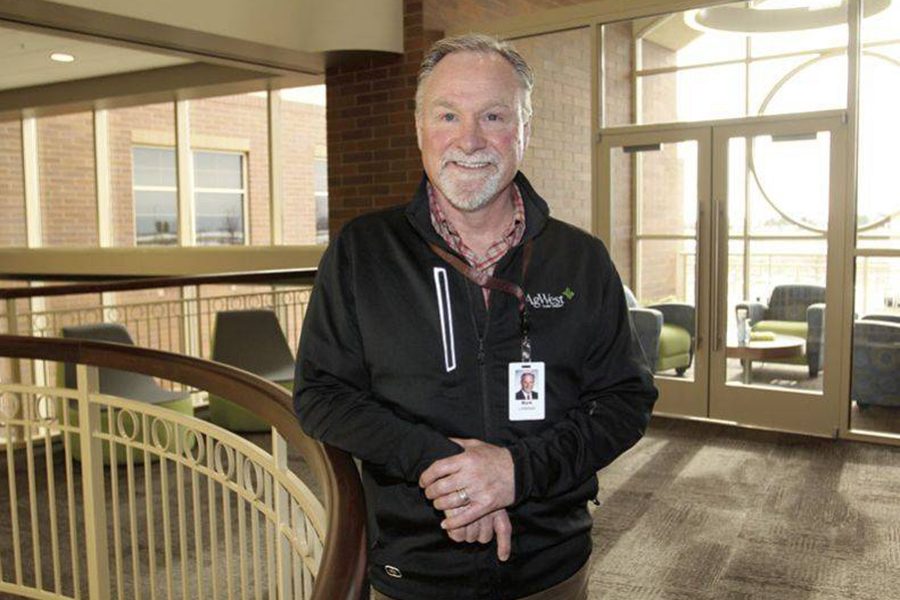
Home » Post merger, AgWest Farm Credit embraces change
Post merger, AgWest Farm Credit embraces change

March 9, 2023
By Karina Elias
Spokane Journal of Business
AgWest Farm Credit, the newly formed agricultural lending association, plans to focus its resources to enhancing its agricultural customer-owners’ access to technology.
This will enable it to modernize its growing methods and deliver efficient and sustainable products, said Mark Littlefield, president and chief executive officer.
Spokane-based Northwest Farm Credit Services and Rocklin, California-based Farm Credit West completed a merger on Jan. 1 to form AgWest Farm Credit.
AgWest will serve 22,000 customers throughout 59 locations in seven western states consisting of Washington, Idaho, Montana, Oregon, California, Arizona and Alaska.
It has a branch at 9915 Saint Thomas Drive in Pasco.
The combined organization had $30 billion in assets as of Jan. 1, Littlefield said.
Northwest Farm Credit’s assets totaled $15 billion on Sept. 30, up from $13.9 billion a year earlier, according to the most recent call report filed with the federal Farm Credit Administration. Northwest FCS’s net income was $88 million for the third quarter of 2022, up from $86.8 million in the year-earlier quarter.
Farm Credit West’s assets totaled $14.1 billion on Sept. 30, up from $12.6 billion a year earlier, and its net income was $86 million for the third quarter, up from $76 million in the year-earlier quarter.
Littlefield sees the merger as a forward-looking joining of resources rather than financial need.
Nate Riggers, a farmer in Nez Perce, Idaho, and board chair for Northwest Farm Credit Service, said that while mergers are typically seen as one strong institution acquiring a smaller institution, that’s not the case with AgWest.
“This is really a merger of equals,” he said. “Both institutions are similar in size, and we saw it as an opportunity to pull our resources and make ourselves more resilient for the future.”
Littlefield said the agricultural industry that AgWest serves has been changing dramatically for decades, mostly centered around agricultural consolidation. As the organization’s customers continue to consolidate and grow larger, so do their needs, Littlefield said.
“It was clear that the trajectory we were on, we would be able to serve more customers as a combined organization than either one of us will be able to do 10 years from now,” he said.
Agricultural technology – GPS technology, heat and moisture sensors, and robots – is changing rapidly, and the cost of that change is expensive, Littlefield said. Being able to finance that technology as a larger organization gives AgWest more capability that Northwest FCS and Farm Credit West would have been able to deliver independently, he said.
“(Farmers) need us to be there for them not only to understand why they need the technology, but also to help them access it, implement it, and understand the risks associated for their business,” he said.
AgWest is a mission-based lender that provides financing and related services to ranchers, agribusinesses, commercial fishermen and timber producers.
Riggers said AgWest’s customers range from a small organic produce farm outside of Seattle to some of the largest seafood processors on the West Coast.
“We needed this merger in order to better serve all our customers, from the smallest to the largest,” he said.
By combining the two institutions, AgWest is better prepared to overcome challenges that it foresees impacting farmers and customer-owners, he said. For example, farmers are confronted with the need to modernize their methods to grow products more efficiently and sustainably, Littlefield said.
The organization also hopes to improve its ability to attract, develop, and retain high quality employees and meet their needs, he said.
AgWest has 1,058 employees, 315 of whom are based at the Spokane headquarters. Littlefield is the former president and CEO of Farm Credit West and recently bought a home in Spokane. He will be transitioning there over the next 90 days to lead AgWest.
Littlefield, who has a background in finance and economics, said he joined the farm credit industry by accident. He hadn’t planned to stay long-term, but after working with farmers and the association’s employees who are committed to ensuring those farmers have what they need in order to grow food, he saw working in farm credit financing as a purpose-driven life rather than a career.
“It was an opportunity to be part of something bigger than just what I wanted to do,” he said. “We take our lead from our customer-owners and the fact that that there is purpose in it for them. It’s something you have to know and love.”
Littlefield said he looks forward to training and development services AgWest will have the capability to offer.
In addition, he looks forward to helping customers support the communities they live in. AgWest makes contributions into donor-advised funds for customers to support needs in their communities, such as new hoses for a fire department or resources for a school district.
“(Customers) get to be the ones to engage those resources into their communities,” he said.
AgWest is part of the Farm Credit System, a network of borrower-owned agricultural lending institutions that was created by Congress in 1916 and charged with financing agriculture, he said.
Littlefield explained that agriculture is cyclical and experiences boom-and-bust periods, and farmers 100 years ago had trouble financing their business because banks would pull out during bust cycles, leaving farmers without credit.
Littlefield added that at the time the Farm Credit System was created, the U.S. had recently entered World War I, and farmers had a difficult time finding financial resources; long-term lending in agriculture was considered risky. Congress evaluated the importance of having a stable food supply, especially in the midst of global war activity and founded the Farm Credit System.
“They recognize that if they could feed their own population even through war time … it was a critical component of national security,” Littlefield said.
Real Estate & Construction
KEYWORDS march 2023





